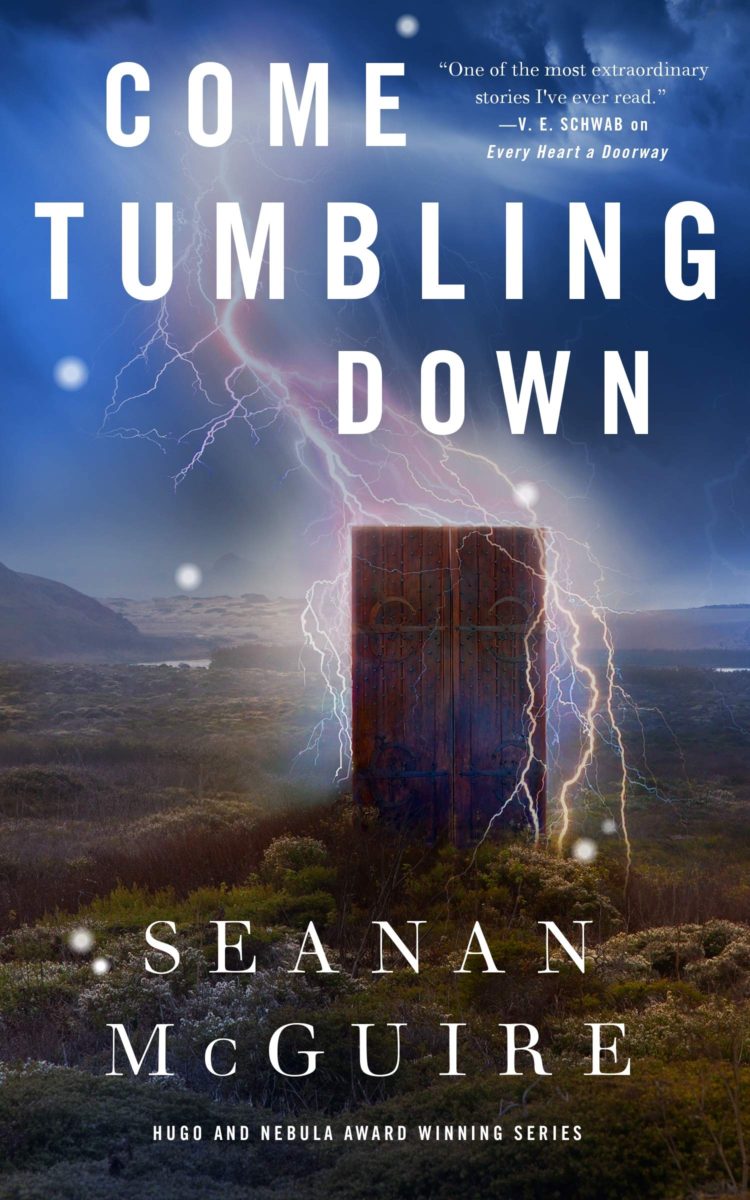Seanan McGuire’s Wayward Children series has been brilliant from start to finish, book to book, and she’s so prolific that I’m running out of ways to encourage people to read it. Would threats work? Read this book or your life will be just so much emptier. There will be a sorrow you’ll only be able to glimpse out of the corner of your eye, an absence, a shadow that will haunt you. You will miss something you never knew you needed. You’ll be sad if you don’t read these books.
Not that you won’t feel a measure of sadness reading the books, too. These novellas have never pulled their punches when it comes to the toll of heroism, and the cruelty of growing up different. But between the bitter challenges are the sweet moments of connection and fulfillment, and the hope that growing up doesn’t have to be awful.

The books alternate between looks at the past of certain people associated with the School for Wayward Children and a central core of characters in the present. Come Tumbling Down is a “present” book, featuring the characters who were introduced in the first volume, Every Heart a Doorway. It begins with Christopher, a young man whose world was made of dancing skeletons and whose true love was a skeleton girl with butterflies beating in her chest. He always shared a certain connection with Jack, a girl from a different death-filled world, but he’s still surprised when she shows back up.
The two major spectrums of the multiverse are between Logic and Nonsense, and the more typical Virtue and Wickedness. But there’s an implied third, a spectrum between Innocence and Morbidity that the children all recognize. Many fear those from “morbid” worlds like Christopher’s skeleton land of Mariposa, even though it’s quite Virtuous. And the Moors may be Wicked, but it’s as much the dead and undead that unnerve others as it is the harsh rules of the world. Christopher and Jack, though their worlds and their temperaments are very different, do form a friendship as a result of being the misfits even among misfits.
Jack and her now-fiancée Alexis arrive back in Christopher’s room through a door of lightning, fleeing a bloody catastrophe on the Moors. Jack’s sister Jill has once again decided that her vampiric consummation is more important than anyone or anything else, and has switched bodies with her twin. This is disastrous for Jack, not just because of her sister’s betrayal but because of her own OCD, which makes living in a vampire-touched, unclean body unbearable. Come Tumbling Down takes mental health and OCD seriously. There are some strong rebuttals to some of the arguments that you can either will yourself or love someone else out of their illness, and some good discussions of the different ways that body dysphoria can affect people. Jack desperately needs help to make it right, and Christopher volunteers along with several others.
Kade, the Goblin Prince in Waiting and also heir presumptive to the headmistress of the Wayward School, provides a level head and a brave—if broken—heart. Sumi serves as the wise fool of the group. Her Nonsense world of Confection would seem to be at odds with the harsh and logical world of the Moors, but she copes better with uncertainty and confusion than the rest of her classmates. McGuire also uses Sumi as a commentary on the nature of both portal fantasy and storytelling in general, having her speak to the inherent absurdity of getting kids to do your fighting.
Newer student Cora (whose first appearance was in Beneath the Sugar Sky) was a mermaid in her world, but now she has to wear her scales and tail “on the inside.” She has a surprisingly crucial role in widening the world of the Moors, showing us the sea and the Drowned Gods. She also was repeatedly asked to choose between the Moors, which were closer to her ideal undersea home, or the uncertain possibility of getting what she actually wanted, a return to her actual home world. Her tragic inner turmoil was one of the best parts of the book, since compromising between dreams is one of the things they never tell you about growing up.
The counterbalance to the grief and difficulty are the relationships and community of understanding built over the course of the book and the series. The no-longer-quite-children have wonderful (if complicated) friendships, and their mutual support is a balm. And beyond even that is Alexis and Jack’s love, which is so incandescent that it could well be classified as its own strain of lightning.
But grief there is, and a certain amount of monstrousness. Not just in the antagonists, but in the protagonists as well, the people asked to make terrible choices about what parts of themselves and others they will sacrifice for a greater good—or a greater neutral. The Moors is not a good place. The best anyone can hope for is balance. Jack wants to find that balance, but knows that one way or another, she will have to embrace the bitter if she wants to keep hold of the sweet.
There isn’t truly a happily ever after, not only because monsters are the rightful rulers of the Moors, but also because there never are any real endings. Come Tumbling Down is the fifth book of eight; it certainly makes that clear. And that can be terrible, to know that doors may not open and families may never become what you need them to be. But it can also be wonderful, full of magic and love and lightning.
Come Tumbling Down will be released January 7.
